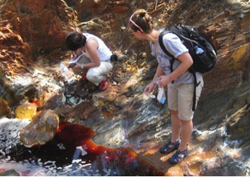 |
|
|
Fall 2011 Our Students: The Latest from UWAB's Greatest A Brief Survey of Grad Student Activities Graduate students in astrobiology are an industrious lot; rarely is there a dull moment in their academic lives. A recent survey of students uncovers that our astrogiologists-in-training can be found looking for answers in the lab, in the air, in the arctic, and beyond.
Beyond our own solar system, Ty Robinson (Astronomy) has been working on detecting extraterrestrial oceans from the glint of light sparkling on their surface; while Aomawa Shields (Astronomy) is working on determining what combination of planetary parameters can cause a planet to turn into a giant snowball, as has happened to Earth in the past. And Michele Cash (Earth & Space Science) is studying the region above our own planet, where plasma physics processes drive ring current enhancements, creating large geomagnetic storms and substorms. Meanwhile, back here on Earth, Jesse Colangelo-Lillis (Oceanography) is working on understanding how viruses withstand the freezing waters of the Arctic Ocean and Eva Stueeken (Earth & Space Science) is studying selenium isotopes to find out what can be gleaned about our planet’s deep past. David Smith (Biology) is leading a NASA-sponsored balloon mission to sample microorganisms in the stratosphere, a mostly unexplored environment that in many ways resembles conditions on extraterrestrial worlds: dry, frozen, irradiated and nutrient-deprived. Meanwhile, Marcela Ewert Sarmiento (Oceanography) is working on studying how “goop” (exopolysaccharides) collected from Arctic microbes can act as an effective antifreeze -- “the goop is everywhere!” she says. AB students have circled the globe in their pursuit of knowledge -- and have left the confines of their “home discipline” in the process. Aomawa, an astronomer, spent time studying lipid vesicles at JPL in California. Rika Anderson, a biological oceanographer, collected old rocks in Cyprus to study ancient microbial metabolisms. And Meg and Elena, Mars modelers, sampled acidic waters from the Rio Tinto in Spain (see photo). Jesse, also a biological oceanographer, went to Australia to study the isotopic composition of molecules derived from ancient marine organisms preserved for hundreds of millions of years in Australia’s sedimentary rocks. Meanwhile, Tom Tobin (Earth & Space Science) rides helicopters in Antarctica to determine the cause of the extinction event that killed the dinosaurs -- "it may have been more complex than a simple asteroid impact,” he says noting that rapid climate change would be a potential contributing factor. As extensive as that litany of research topics may seem, this is but a minor sampling -- with about 27 students in the program, the research conducted by the whole of the student body covers past and present, Earth and beyond. Only time will tell where their research leads them next.
Photo: Meg Smith and Elena Amador sampling the Rio Tinto, an acid mine drainage site that is viewed as an analog for potential environments on early Mars. Smith and Amador visited the Rio Tinto as part of the International Conference on Exploring Mars Habitability in Lisbon, Portugal this past summer.
|
|
 Mars is a hot topic, drawing the attention of many of our students and graduates. Elena Amador (Earth & Space Science) is studying mineralogy on Mars orbiter photos to gather information about possible water in Mars’ past, while Meg Smith (Earth & Space Science) constructs models to determine how perchlorate (a salt found by the Phoenix lander in 2008) could have formed in Mars’ early atmosphere, and Osa Igbinosun (Earth & Space Science) is studying how water adsorbs to soils similar to those found on Mars to determine how it might have functioned in mineralogical and biological processes. Astrobiology Post-docs Sanjoy Som (Earth & Space Science) and Billy Brazelton (Oceanography) are investigating the connection between geology, geochemistry, and microbiology in systems where water interacts with low-silica, high-magnesium rocks, which may provide insight into the habitability of potentially similar systems on Mars.
Mars is a hot topic, drawing the attention of many of our students and graduates. Elena Amador (Earth & Space Science) is studying mineralogy on Mars orbiter photos to gather information about possible water in Mars’ past, while Meg Smith (Earth & Space Science) constructs models to determine how perchlorate (a salt found by the Phoenix lander in 2008) could have formed in Mars’ early atmosphere, and Osa Igbinosun (Earth & Space Science) is studying how water adsorbs to soils similar to those found on Mars to determine how it might have functioned in mineralogical and biological processes. Astrobiology Post-docs Sanjoy Som (Earth & Space Science) and Billy Brazelton (Oceanography) are investigating the connection between geology, geochemistry, and microbiology in systems where water interacts with low-silica, high-magnesium rocks, which may provide insight into the habitability of potentially similar systems on Mars. 